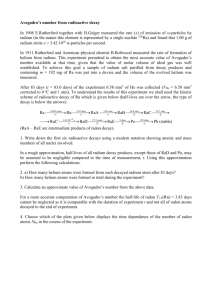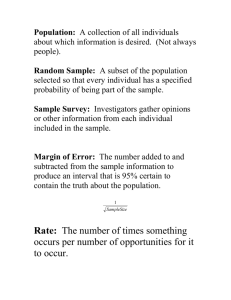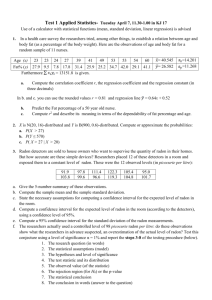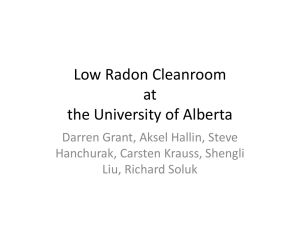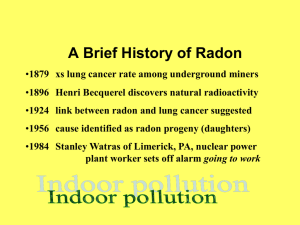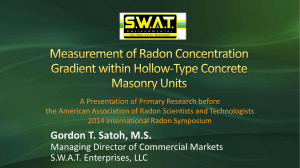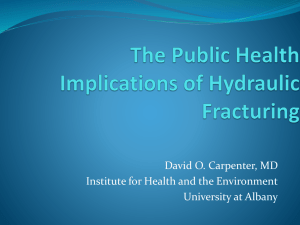Investigation of radon and radium content of thermal and
advertisement
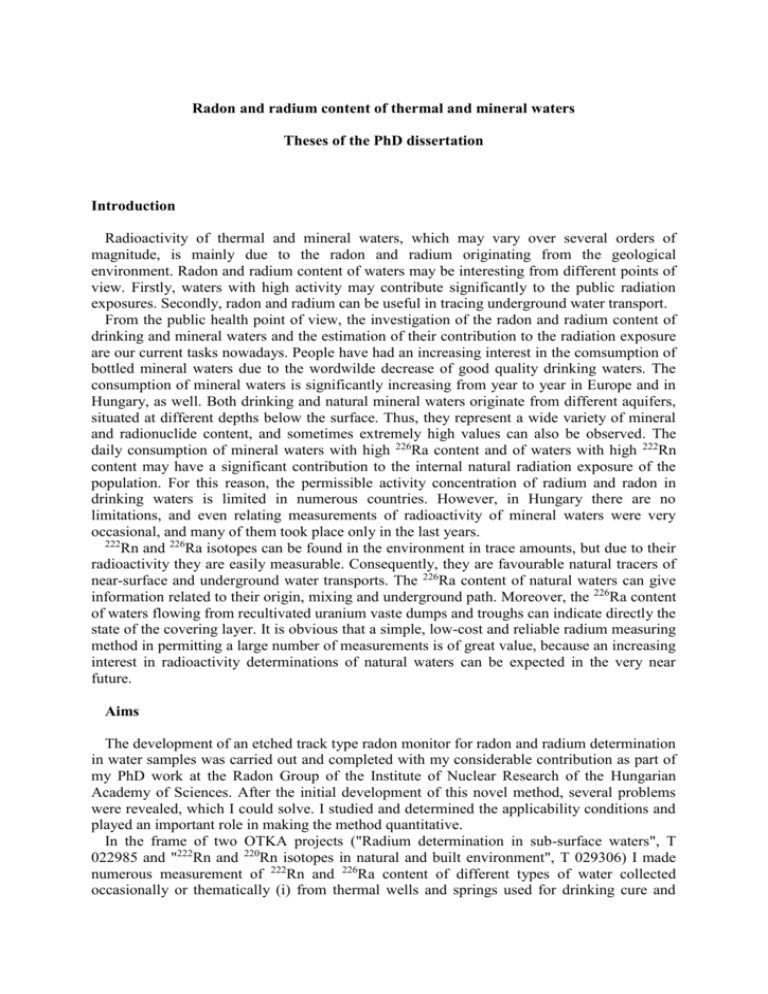
Radon and radium content of thermal and mineral waters Theses of the PhD dissertation Introduction Radioactivity of thermal and mineral waters, which may vary over several orders of magnitude, is mainly due to the radon and radium originating from the geological environment. Radon and radium content of waters may be interesting from different points of view. Firstly, waters with high activity may contribute significantly to the public radiation exposures. Secondly, radon and radium can be useful in tracing underground water transport. From the public health point of view, the investigation of the radon and radium content of drinking and mineral waters and the estimation of their contribution to the radiation exposure are our current tasks nowadays. People have had an increasing interest in the comsumption of bottled mineral waters due to the wordwilde decrease of good quality drinking waters. The consumption of mineral waters is significantly increasing from year to year in Europe and in Hungary, as well. Both drinking and natural mineral waters originate from different aquifers, situated at different depths below the surface. Thus, they represent a wide variety of mineral and radionuclide content, and sometimes extremely high values can also be observed. The daily consumption of mineral waters with high 226Ra content and of waters with high 222Rn content may have a significant contribution to the internal natural radiation exposure of the population. For this reason, the permissible activity concentration of radium and radon in drinking waters is limited in numerous countries. However, in Hungary there are no limitations, and even relating measurements of radioactivity of mineral waters were very occasional, and many of them took place only in the last years. 222 Rn and 226Ra isotopes can be found in the environment in trace amounts, but due to their radioactivity they are easily measurable. Consequently, they are favourable natural tracers of near-surface and underground water transports. The 226Ra content of natural waters can give information related to their origin, mixing and underground path. Moreover, the 226Ra content of waters flowing from recultivated uranium vaste dumps and troughs can indicate directly the state of the covering layer. It is obvious that a simple, low-cost and reliable radium measuring method in permitting a large number of measurements is of great value, because an increasing interest in radioactivity determinations of natural waters can be expected in the very near future. Aims The development of an etched track type radon monitor for radon and radium determination in water samples was carried out and completed with my considerable contribution as part of my PhD work at the Radon Group of the Institute of Nuclear Research of the Hungarian Academy of Sciences. After the initial development of this novel method, several problems were revealed, which I could solve. I studied and determined the applicability conditions and played an important role in making the method quantitative. In the frame of two OTKA projects ("Radium determination in sub-surface waters", T 022985 and "222Rn and 220Rn isotopes in natural and built environment", T 029306) I made numerous measurement of 222Rn and 226Ra content of different types of water collected occasionally or thematically (i) from thermal wells and springs used for drinking cure and bathing in Budapest, (ii) from drilled wells of drinking waters deepened in the Mórágy granite block, (iii) from thermal and natural mineral waters in Hargitha County, Romania and (iv) from bottled mineral waters commercially available in Hungary. The aim was to get information about the radium and radon concentrations of waters occurring in our environment and to estimate the committed effective doses originating from drinking waters. Methods Radium, radon and their decay products can be measured by the detection of either alpha, beta or gamma radiation. In our study, we used etched track radon detectors and, in cooperations, we also applied gamma-spectrometry and radon emanation method. The etched track method for the determination of radon and radium content developed by us is based on a small volume diffusion type etched track radon monitor, which is tightly enclosed into a gas permeable foil and is immersed into the water sample. Radon from water diffuses through the foil into the internal air volume of the radon monitor, where it exposes an about 1 cm2 area CR-39 etched track detector. The exposure time is 12-14 days for 222Rn and about 30 days for 226Ra determination at regulated temperature. After exposure the CR-39 detectors were etched in 6.25 mol/dm3 NaOH solution at 70˚C for 5 hours and the alpha tracks were counted manually under an optical microscope. Using consistent equations, deduced from the sensitivity of the method, which was determined both theoretically and experimentally, the unknown activity concentrations of radon and radium can be calculated from the measured track densities. Results 1. I have determined theoretically and shown with experiments that the sensitivity of radium and radon determination method of water samples by etched track type radon monitor is dependent on the temperature of the water samples during exposure. I have demonstrated that the temperature dependence of the sensitivity of the method can be explained by the temperature dependence of the invert of the Ostwald partition coefficient of radon between water and air phases [1, 2]. 2. I have determined both theoretically and experimentally that the sensitivity of this method is dependent on the volume of the water sample. I have showed that the volume of 0.72 dm3, used in our experiments, is adequate, since increasing the volume of the water sample does not increase significantly this sensitivity. However, by decreasing the volume of the sample, the sensitivity decreases fast [2, 3]. 3. Considering the diffusion coefficient of radon in water, I have determined both theoretically and experimentally the track density measurable on the track detector as a function of exposure time. The form of the track density versus exposure time curve depends through the effective diffusion coefficient of the radon gas in water on the amount of water volume, which interacts with the enclosed air volume. Comparing the theoretically calculated curve with the experimental data, I have concluded that the natural mixing of the water is sufficient for the radon monitor to interact with the whole water volume in the glass vessel [1, 2]. 4. In the case of a newly developed method it is important to perform intercomparison measurements with other well-known, widely used methods. On the course of such an intercomparison the data obtained by our etched track radon monitor method were compared with the data measured by gamma-spectrometric and radon emanation methods accomplished by Zoltán Dezső at the University of Debrecen and Pável Szerbin at the Institute for Radiobiology and Radiohygieny, Budapest, respectively. The good agreement for 222Rn and 226Ra activity concentration measurement data of the same water samples measured by the above three methods demonstrates the reliability of our etched track radon monitor method [1, 6]. 5. I have measured radon and radium content of thermal waters collected in medicinal baths of Budapest in 1998, which are used for drinking cure and bathing. From the recent survey new and more precise data were determined for 13 springs along the "thermal line of Buda", on the right side of the Danube. We have recognised that the radon and radium content is also characteristic of the spring groups defined according to geological location and chemical composition. The measured 222Rn and 226Ra data were in the range of 47393 Bq/l (222Rn) and 646-837 mBq/l (226Ra) for the Gellért Hill's Spring Group and were in the range of 18-65 Bq/l (222Rn) and 46-262 mBq/l (226Ra) for the József Hill's Spring Group, respectively. I have estimated the committed dose for patients taking regularly drinking cure from the Rudas and Lukács Drinking Halls [6]. 6. Using the newly developed etched track radon monitor method, the radium content of naturally occurring mineral waters of Hargitha County was measured. The collection of the samples was carried out in 1998-1999 with the help of the Environmental Protection Agency of Csíkszereda and the Institute of Public Health of Hargitha County. I have determined new data of 36 water samples, which are mostly used as a daily drink by the local population. On the basis of my data, in the range of 10-703 mBq/l, the committed effective dose received from radium of the consumed mineral waters by the public was estimated. It was found, that it is 0.001-0.036 mSv/year in case of adults and 0.003-0.192 mSv/year for 2-17 year old children [4, 5]. 7. Nowadays people are drinking more and more mineral water, and this demand is reflected in the wide variety and big amount of bottled mineral waters available in corner shops and supermarkets. The European average consumption is 120-130 litre/year/capita. The Hungarian average consumption doubles in 2-3 years, and reached the value of 40 litre/capita in 2000. Therefore, it seems very reasonable to extend the legislation procedure for the radioactivity content of waters that are to be qualified as natural mineral, medicinal or drinking water. By the etched track detector method I have studied the radium content of 14 bottled natural mineral waters originating from different regions of Hungary. The measured data cover a very wide, three order of magnitude range from 7-10 mBq/l to nearly 3000 mBq/l. It is interesting to note that the mineral waters originating from the Upper Pannonian sedimentary layers in the Great Hungarian Plain have much lower radium content than the thermal waters coming from the deep Triassic-karst (carbonate and dolomite) in the region of Budapest. My data were compared and shown a good agreement with data measured by other researchers using different methods. These data also contribute to a national database concerning the radium content of Hungarian bottled mineral waters. In consequence of a warning note on the high radium content of the mineral water produced by the German owned Apenta Co., the Company has lately introduced a radium removal process to prevent people from high internal doses due to the consumption of this brand [6]. 8. Radon activity concentration of drinking waters used in Feked, Véménd and Szebény was investigated in 1999 commissioned by the City Halls of these villages. The drilled wells of the waterworks are situated on the eastern side of the Mecsek Mountain (on the Mórágy granite block). Besides looking for relation between the radium content and the origin of the water as well as the geological environment of the water path, I have calculated the annual committed dose of the inhabitants and I have obtained 0.07-0.346 mSv/year depending on the radon content. These measured data have also contributed to the decision to close the public well of Feked having the highest radon content (173 Bq/l) [4].


